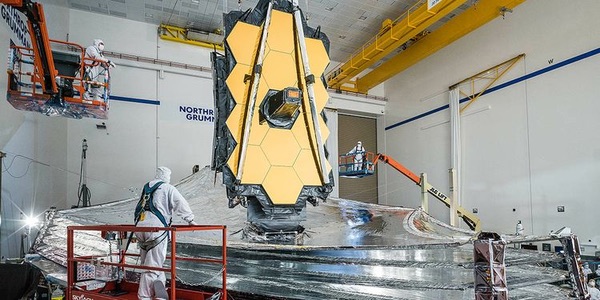Creating an inspector “mascot” satellite for JWSTby Philip Horzempa
|
| Another clue that the NRO has valuable assets in geosynchronous orbit is the large number of inspector satellites sent there. |
The Webb telescope fits into the category of “project of national importance.” The National Reconnaissance Office (NRO) also launches satellites that are not only expensive and complex, but which are vital to national security. For some time, the Department of Defense has been interested in monitoring the status of the NRO’s orbital assets.
One example of an intelligence satellite in geosynchronous orbit is the Mentor (or Orion) series. As with all NRO spacecraft, information is limited, but it seems that this craft utilizes a 100-meter deployable mesh antenna. This allows it to monitor radio communications from that altitude. An artist’s depiction gives an idea of its magnitude.
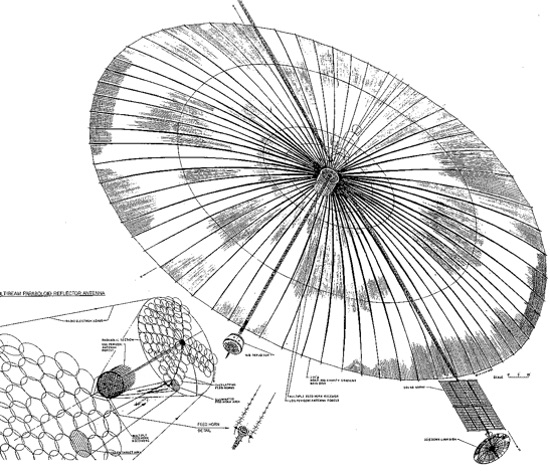 Mentor satellite (credit: C.P. Vick) |
Geosynchronous orbit is also an ideal perch for persistent visible-light recon imaging. At that distance, a satellite would need a very large aperture to obtain photos with enough resolution to allow for target analysis. It is difficult to know, but the NRO may have launched spy satellites with large-aperture optics similar to the design of the Webb telescope. The military took an active interest in segmented-mirror design some years ago with a project referred to as the Segmented Mirror space Telescope (SMT). An article stated “Like the Webb telescope, the SMT employs a large, lightweight deployable mirror system to increase optical resolution on-orbit while reducing telescope weight. The mirror segments of such telescopes collapse into a small volume to fit into their launch vehicles and then open to their full diameter in response to a wireless command after launch. The segments must be very accurately aligned after deployment, and their surfaces must be actively controlled using hundreds of tiny actuators. Adaptive optics systems work by measuring the distortion in an image and using ‘adaptive’ optical elements – usually deformable mirrors – to restore the image by applying an opposite, cancelling distortion.” [1]
The NRO does not release a lot of information about their projects, but this rare insight indicates that they may have JWST clones of some fashion in orbit.
Space situational awareness
Another clue that the NRO has valuable assets in geosynchronous orbit is the large number of inspector satellites sent there. As with the segmented test telescope, the agency has released some limited information about these craft. The motivation behind these efforts was discussed in connection with the GSSAP or Geosynchronous Space Situational Awareness Program. The phrase “situational awareness” says it all. This allows for the “characterization of man-made objects” in geosynchronous orbit (as stated by the Defense Department). The satellites have the ability to perform rendezvous and proximity operations, or proxops, allowing the GSSAP satellites to “maneuver near a resident space object of interest, enabling characterization for anomaly resolution.” That last phrase, again, points out the NRO’s keen interest in determining the status of its own hardware in orbit, especially if an issue arises. The first launch of GSSAP satellites occurred in 2014, with another pair of satellites set to be launched in early 2021 on an Atlas 5 rocket.
One of the early inspector craft was Prowler, launched by the Space Shuttle in 1990 during mission STS-38. Little is known about Prowler, but it may have been based on Hughes Aircraft’s HS-376 standard satellite. Apparently, it was able to maneuver within a few meters of its targets.
The SMT dates to 2005, but an article from April 1966 in the Missiles and Rockets magazine indicates that the heritage of JWST stretches back to the first decade of the Space Age. The sketch from M&R shows a concept for a space telescope that not only used a segmented-mirror design, but which also incorporated active shape control for individual mirrors.
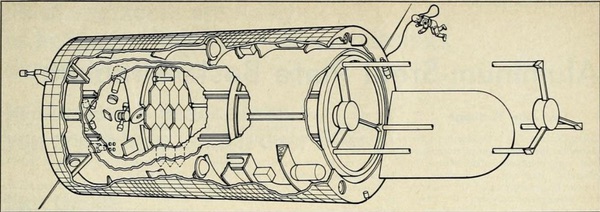 A 1960s-era concept for a large space telescope with segmented mirrors. (credit: Missiles and Rockets) |
In 2006, two small inspectors were launched into geosynchronous orbit by a Delta II rocket. Each MITEX satellite weighed only 225 kilograms, allowing them to be quite nimble. In late 2008/early 2009, they closed in on a failed DPS satellite to ascertain what had befallen the 2,270-kilogram satellite. Since it was a sensitive mission, nothing else was revealed.
| The most complex deployment will involve the telescope’s sunshield. This 15-by-20-meter structure represents the largest gossamer membrane to be deployed in space. |
In April 2018, the Defense Department launched the Mycroft satellite into geosynchronous orbit. It proved its usefulness in October 2019 when it was sent on an inspection mission. The S5 satellite had been launched to geosynchronous orbit but its radio system did not function. The DOD, by some means, determined that its solar panels had deployed, but without communications, there was no way to tell what had happened. That is where the Mycroft spacecraft came on the scene. It was sent to rendezvous with the S5 craft and to inspect it. There have been no reports on the results of that operation.
An essay from 2016 (see “CubeSat proximity operations: The natural evolution of defensive space control into a deterrence initiative”, The Space Review, January 18, 2016) reviews more of the DOD’s efforts to utilize cubesats.
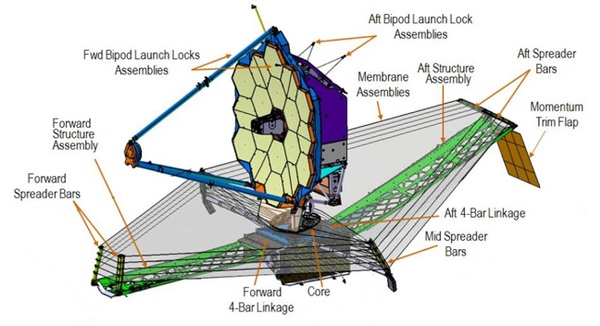 A diagram of JWST highlighting its various deployable elements (credit: NASA) |
Sunshield and stray light
There will be 22 individual deployment activities for Webb after launch. These cover the solar arrays, high-gain antenna, secondary mirror, and the segmented primary mirror. However, the most complex deployment will involve the telescope’s sunshield. This 15-by-20-meter structure represents the largest gossamer membrane to be deployed in space. While being unfolded, care must be taken to prevent the layers from getting tangled, as well as protecting the surface coatings on those layers. To quote NASA, “The sunshield support structure contains well over 7,000 flight parts, including springs, bearings, pulleys, magnets, etc. In addition, the sunshield has hundreds of custom fabricated pieces.”
The sunshield is essentially an independent, very complex spacecraft. Its design, construction, and testing have been the pacing items for Webb’s launch readiness. A sunshield status paper stated that this “subsystem consists of five Kapton Membranes, six Spreader Bars, two Unitized Pallet Structures (UPS), two telescoping booms (Mid-Boom Assemblies, or MBAs), Momentum Trim Flap, the Core Area, and four UPS Bipod Launch Lock attachment points” [2]
Diving deeper into the design, NASA states that there are “about 150 mechanism assemblies that have to function properly to fully deploy the sunshield. Within those mechanism assemblies, there are numerous small parts that work in harmony. The smaller parts include about 140 release actuators, approximately 70 hinge assemblies, eight deployment motors, scores of bearings, springs and gears, about 400 pulleys and 90 cables.”
An essay from NASA states that these mechanisms “release the sunshield membranes from their folded and stowed launch configuration, deploy the supporting structures, and unfold and tension the membrane layers” and that “there are hundreds of magnets and clips to manage the membrane shape and volume during deployment.”
When it is finished, near the center of the sunshield “each layer is separated by only a couple inches, but the layer-to-layer gap increases as you move away from the center, to about a foot between layers around the edges. It will take nearly two days to fully deploy the sunshield system when in orbit.” This degree of complexity is what makes it imperative that the deployment of the sunshield be monitored in real-time.
The sunshield serves two purposes. First, and most important, is blocking 300,000 watts of sunlight. The shield reduces that power to less than two watts transmitted to the telescope. That miniscule amount allows JWST to cool to the cryogenic temperatures necessary for observations in the infrared.
Besides temperature control, the main purpose of the sunshield is protection from stray light. The importance of this cannot be overstated, since JWST omits the optical barrel used in traditional telescopes. With the absence of the light baffling provided by a barrel, the sunshield must deploy to a shape that will block all extraneous light. In order to accomplish that, the location of the edges of the membrane must be maintained to a tolerance measured in centimeters.
After launch, the Gaia astrometry observatory’s sunshield was discovered to be less than perfect in its ability to block stray light. As a result, its ability to scan very faint stars was affected, causing some loss of science. For the Webb telescope, stray light would be a disaster. If the problem were severe enough, much of the science observations would be curtailed.
| Webb’s sunshield will serve as a pathfinder for future large deployable structures such as starshades. A visual record of JWST’s sunshield would be of great value to engineers designing those missions. |
The sunshield must not only unfold but, once deployment is finished, it needs to be in a specific shape in order to function properly. Warps in the gossamer shields are of particular concern. A report by Fellini and Kropp on the challenges in constructing the sunshield stated that in addition “to meeting the complex requirements of the sunshield subsystem, one of the most critical aspects of the structural analysis is the accurate, reliable on-orbit prediction of the global shape, along with determination of any significant local wrinkling.” It further stated that one challenge in sunshield design “is the need to minimize wrinkles. If the sunshield in its fully tensioned state develops deep wrinkles, the layers might come into contact, thereby violating the thermal requirements.” In addition, the analysis “has shown that the presence of even small wrinkles oriented in a critical direction may dramatically increase the amount of heat reaching the equipment. It is therefore critical to be able to predict the shape of the smallest details in the tensioned sunshield, including the wrinkles.” However, the authors pointed out that “analysis of the sunshield in the almost unloaded state is extremely difficult.” [3]
Starshades, planned to operate with future space telescopes, have similar critical tolerances. The purpose of such a shade is to block out the light from a star so that an orbiting exoplanet can be imaged. Since the brightness of an exoplanet can be just one billionth that of its parent star, it is also critical to block the light from our Sun. Any stray light, perhaps from an imperfect edge, would render the starshade useless. Webb’s sunshield will serve as a pathfinder for future large deployable structures such as starshades. A visual record of JWST’s sunshield would be of great value to engineers designing those missions, as discussed later in this essay.
NASA monitoring options
The deployment sequence for the Webb telescope will begin several hours after launch and will take several days to complete. The complex arrangement is well illustrated by a photo of the JWST during testing and a few illustrations of the numerous deployment events.
It has become almost the norm for agencies to include monitoring cameras on their spacecraft. There are several examples of objects that were inspected by sub-satellites ejected by the main payload. Here is an example of a photo of a Chinese space laboratory from just such a craft.
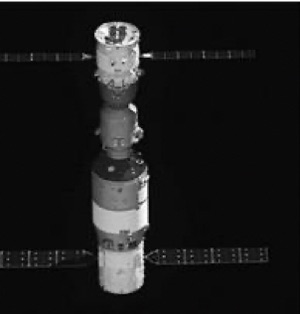 Image of Chinese Tiangong space lab taken from a satellite. |
In 2019, an inspector nanosat was deployed by a Cygnus spacecraft after it had completed its mission to the ISS. This is an image from the video obtained by the Seeker subsatellite after its deployment.
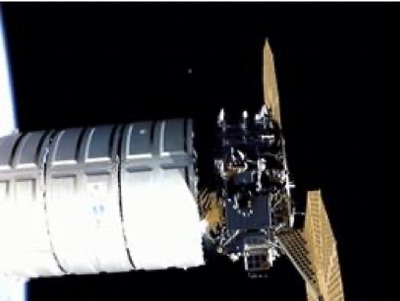 A frame of a video showing a Cygnus spacecraft. |
The first deep-space Orion capsule will include a number of external cameras, notably one for each of its solar arrays.
The Mars 2020 Perseverance rover will utilize an array of monitoring cameras during EDL. They will observe parachute deployment, the skycrane in action, and the rover as it is placed on the Martian surface. A NASA essay points out that “No one has ever seen a parachute opening in the Martian atmosphere, the rover being lowered down to the surface of Mars on a tether from its descent stage, the bridle between the two being cut, and the descent stage flying away after rover touchdown!” This monitoring activity will be able to answer such questions as “How do the wheels and legs respond when the rover finally puts all its weight down on Mars?” The goal is to provide a visual record that will be a treasure trove for engineers. The Mars 2020 website adds that these engineering cameras were assembled from easily available commercial hardware.
Smallsat options
There is a wide assortment of smallsat candidates that could serve as a JWST inspector companion. JPL completed preliminary design of a small monitoring satellite in 2006. It would launch with its target payload, deploy, and then begin its inspection mode. Among its talents, the “Micro-Inspector is capable of holding position and attitude to monitor a particular event on the host” such as a mechanical deployment.
Further, it is possible “due to the low mass of the Micro-Inspector” to have multiple inspectors that would provide different viewing angles. The five-kilogram Micro-Inspector was designed to operate in deep space and had a collection of several cameras that provide high-resolution or context images. To quote that report: “Special attention… was given to safe operations and hazard avoidance.” [4]
| There is a wide assortment of smallsat candidates that could serve as a JWST inspector companion. |
One of the ride-along payloads on the Artemis-1 mission is a cubesat that will perform a fly-around inspection of the SLS second stage. The ArgoMoon satellite will incorporate radiation-tolerant avionics, such as would be required for a mission to JWST’s perch at the L2 location. In addition, the small vehicle has a narrow-angle camera ideal for an inspection mission.
These images are a reminder of how simple hardware issues can threaten a mission. They show astronauts during an EVA on Shuttle mission STS-37 in April 1991. They were sent out to the payload bay when the high-gain antenna of the Compton Gamma-Ray space telescope would not deploy. Insulating material had hung up the antenna boom. With minimal effort, an astronaut was able to push on the boom and get it to deploy.
If something similar occurred during one of JWST’s many deployments, then visual inspection would be key to remediating the situation. In some instances, a small repair craft might be able to put things right. In order to do that, visual data, i.e. photos, would be essential to devising a hardware fix.
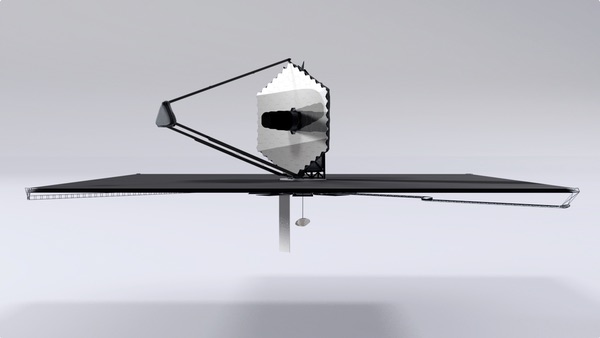 An illustration of the larger variant of LUVOIR, one of the large space telescope missions under consideration in the 2020 astrophysics decadal survey. (credit: NASA) |
Large structures in space
Visual monitoring of the JWST sunshield would contribute greatly to the knowledge base for future missions. A prime example is the starshade that may be built to interact with the Roman Space Telescope, formerly known as WFIRST. The shade will have a diameter of 25 meters and will therefore need to be folded up during launch. Once in space, it will need to be deployed to an accurate shape, one even more demanding than that of Webb’s sunshield.
The proposed HabEx telescope may use a monolithic mirror, but another mission under consideration the Large UV Optical Infrared (LUVOIR), features large optics that will need to be deployed, much like JWST. In addition, a 75-meter starshade that could accompany it will have a surface area almost 10 times that of the Roman Space Telescope’s starshade. The zero-g environment in which these structures operate adds an element of chaos to their dynamics. Gathering empirical data from the operation of other large structures is vital to advancing our understanding of such dynamics. Hence, there is no substitute for visual documentation which monitoring of the deployment of Webb’s sunshield could provide.
An example of the importance of getting visuals occurred during the recent sampling operation of the OSIRIS-REx asteroid spacecraft. Its onboard monitoring cameras clearly showed material escaping from its sample canister. This led to a modification of the flight plan. Several activities were canceled and the canister was loaded into its return capsule as soon as was practicable. This change in mission ops all flowed from the availability of images that provided information that no other instrument did. And just this month, the operations of China’s Chang’e-5 spacecraft were visually monitored as it collected samples on the Moon, docked in lunar orbit and transferred those samples to an Earth-return vehicle.
Such monitoring has become the norm for space missions. The Webb telescope is not equipped with onboard cameras, but a shepherding craft could provide that data. Even if NASA chooses not to take up that option, it could issue a directive that all such high-value missions must have onboard engineering cameras. The technology now exists to include low-mass, high-definition cameras.
NASA learned a similar lessons with the failure of the Mars Polar Lander in 1999. The lack of a radio link during its landing operations left NASA with a situation in which it had little, or no, data for forensic engineers to track down the cause of the loss. That mishap led to a new policy that mandated that a radio link must be present during all mission critical events. The same policy should apply to visual monitoring.
The MarCO smallsats that accompanied the Insight Mars lander are a good example of how NASA can marshall the will for this. However, there are many candidates that could fulfill the role of JWST Inspector. If NASA does not include an Inspector on Webb’s Ariane 5, then it should issue an RFI for such a vehicle to be ready if there is an issue with the mission. That satellite would be launched to L2 as a ride-along on a mission targeted for geosynchronous orbit. The Inspector could then thrust out from the transfer orbit to L2 to rendezvous with JWST.
With an investment of nearly $10 billion and 20 years of work, it is imperative that NASA document the deployment of the Webb telescope. The best time to begin is now.
References
- “NPS New Home for Giant Segmented-Mirror Space Telescope”; Barbara Honneger, February 18, 2010; Naval Postgraduate School
- “Status of the JWST Sunshield and Spacecraft,” Arenberg et al; Space Telescopes and Instrumentation 2016, Proceedings of SPIE, vol. 9904
- “James Webb Space Telescope Sunshield: Challenges in Analysis of Gossamer Structures”; Fellini and Kropp; Northrop Grumman Space Technology; Technology Review Journal 2008
- “Micro-Inspector Spacecraft: An Overview”; Goldberg et al; 2006,
Note: we are temporarily moderating all comments submitted to deal with a surge in spam.
